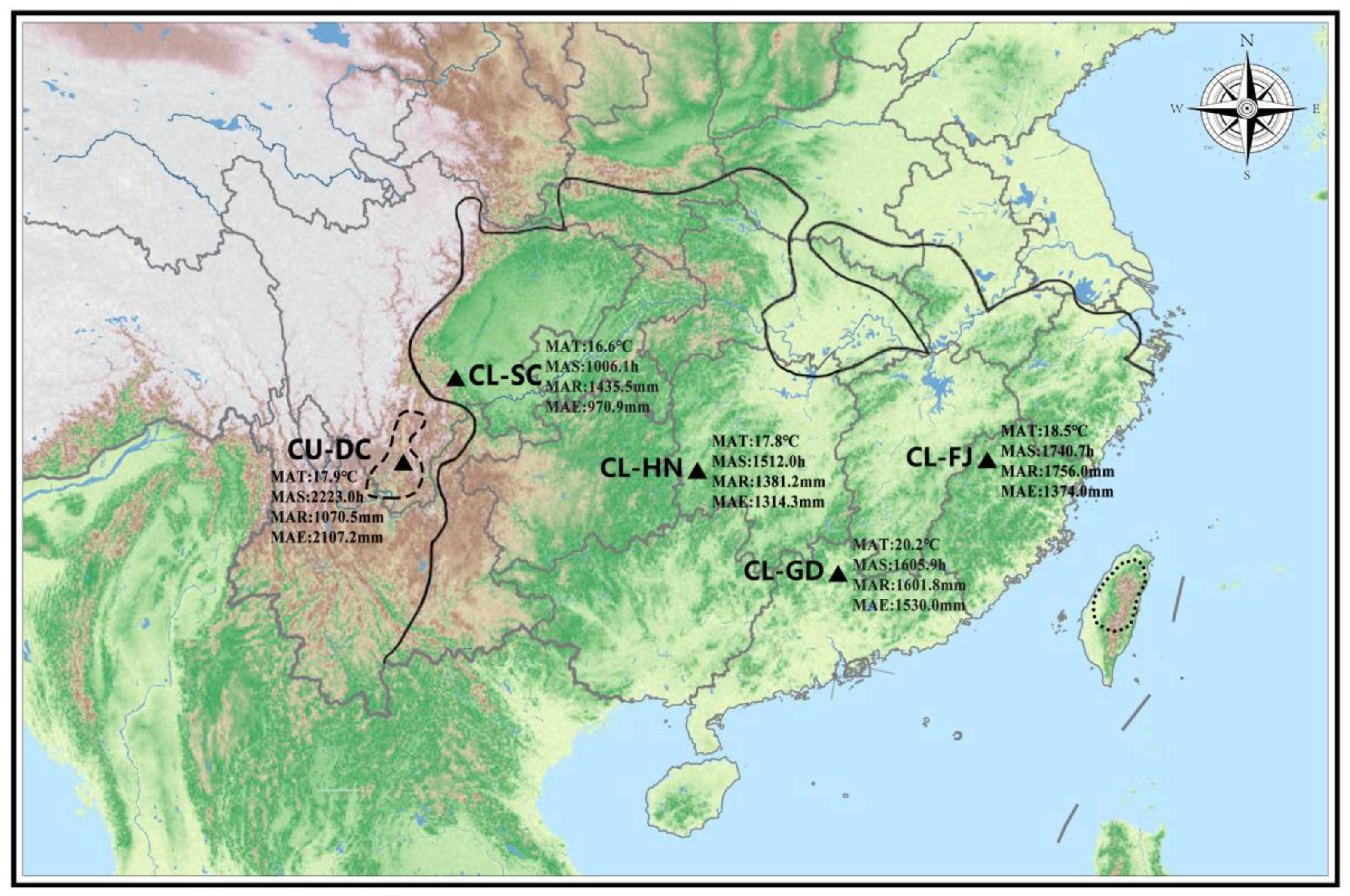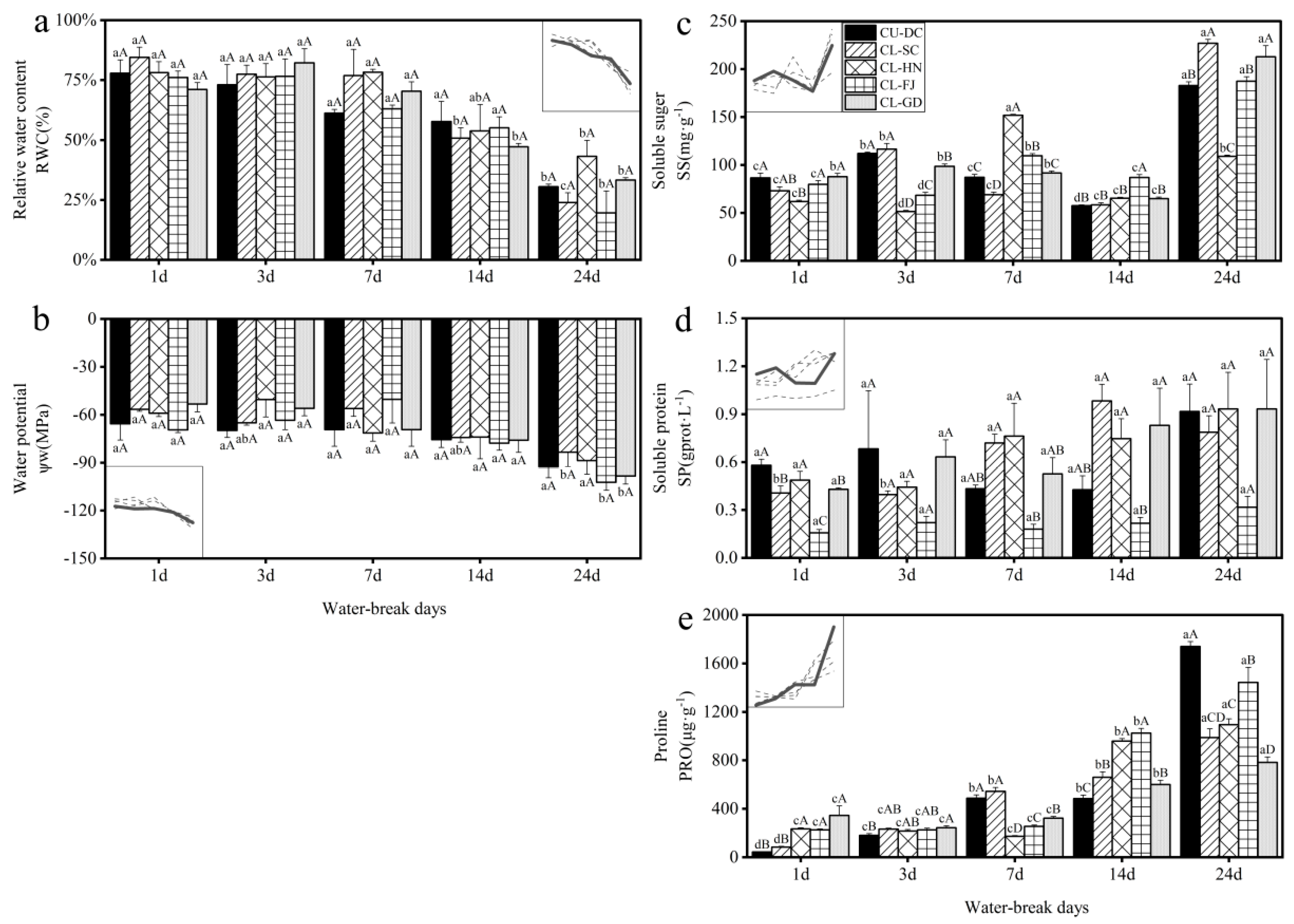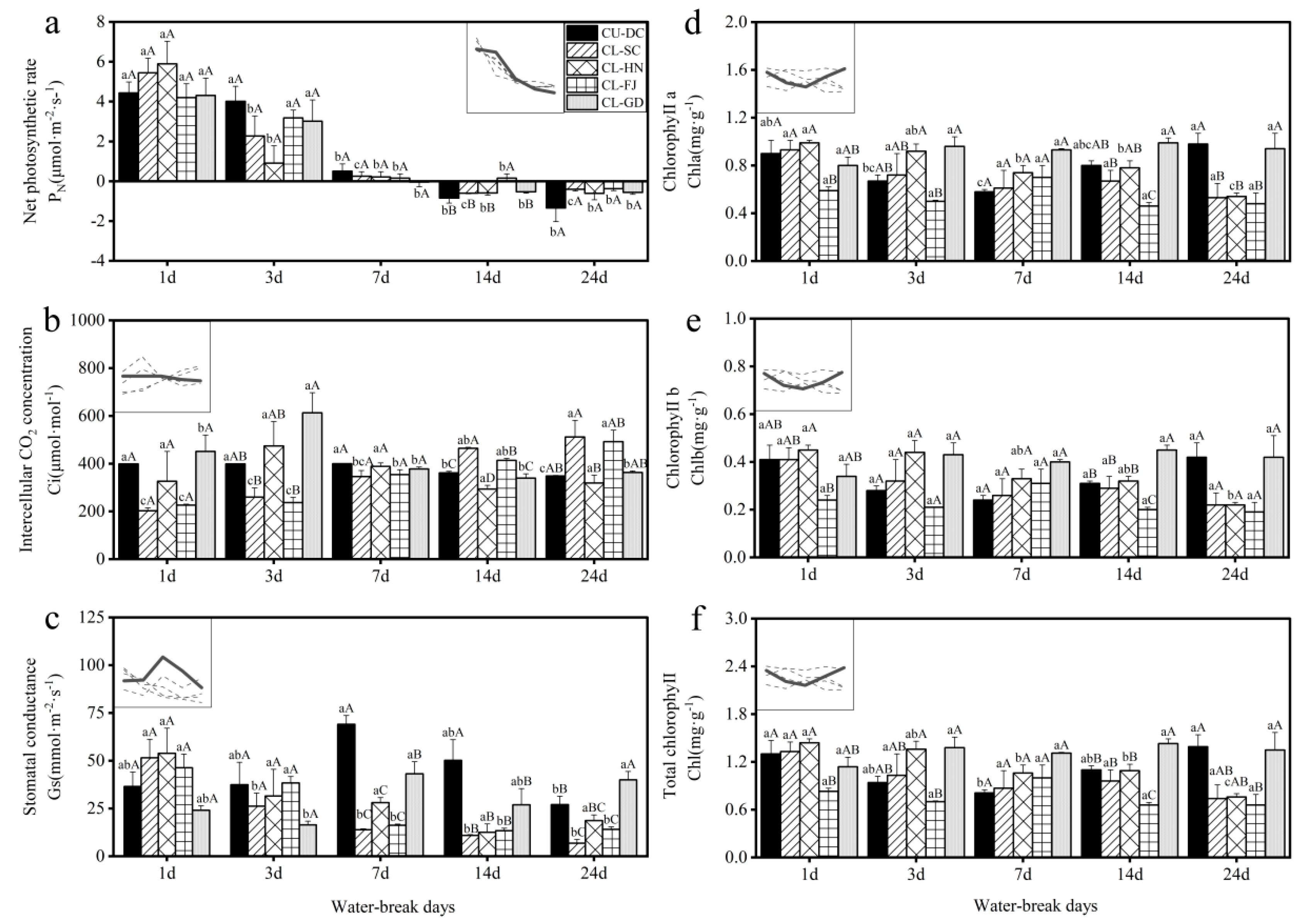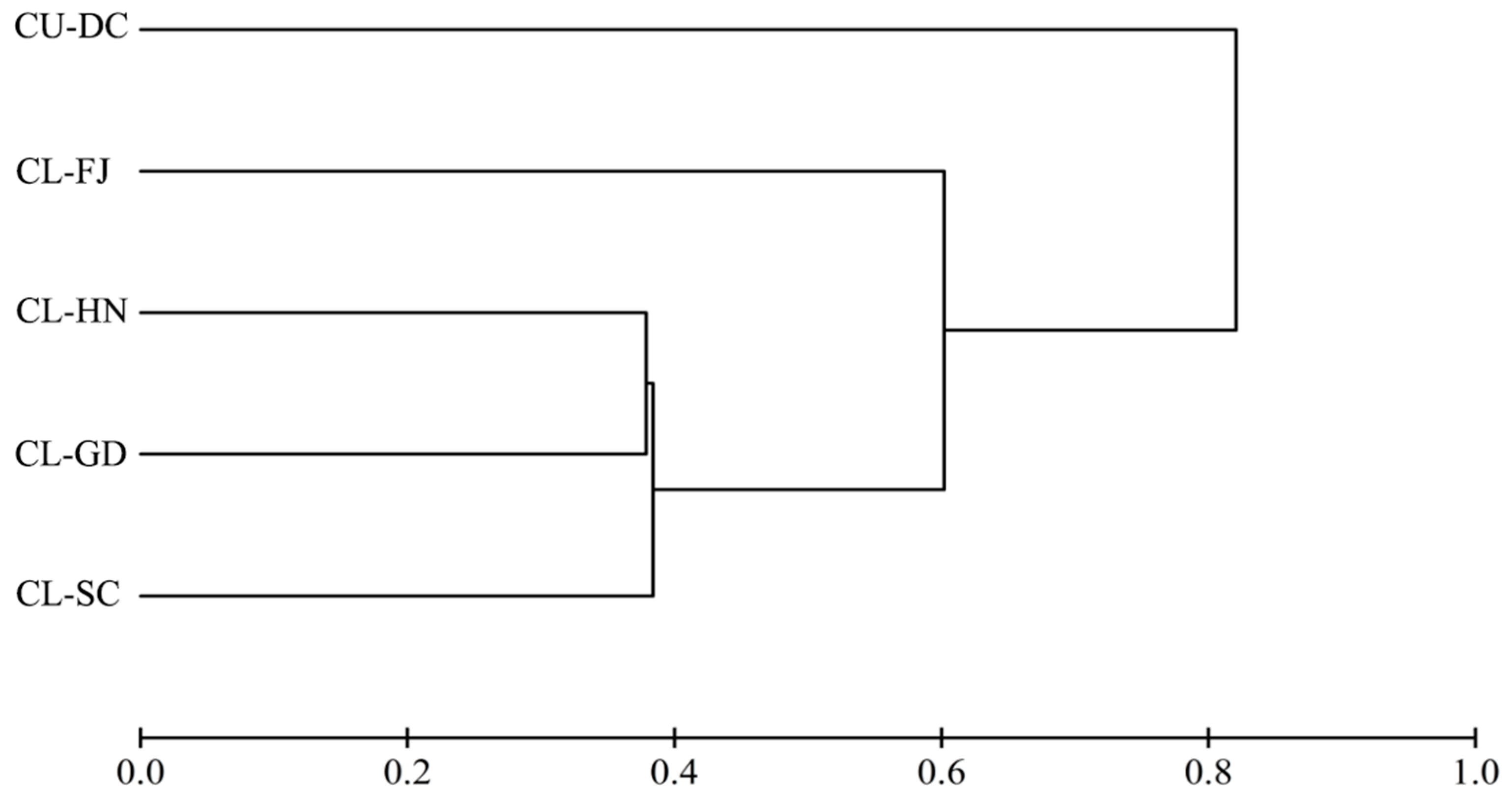Comparative Evaluation of Physiological Response and Drought Tolerance between Cunninghamia unica and C. lanceolata Seedlings under Drought Stress
Abstract
1. Introduction
2. Materials and Methods
2.1. Material
2.2. Experiment Design
2.3. Determination of Drought Tolerance Indexes
2.3.1. Determination of Relative Water Content, Water Potential and Osmoregulators
2.3.2. Determination of Chlorophyll Content, Net Photosynthetic Rate, Intercellular CO2 Concentration and Stomatal Conductance
2.3.3. Determination of Cell Membrane Permeability, Malondialdehyde Content and Antioxidant Enzymes Activity
2.4. Statistical Analysis
3. Results
3.1. Water Pysiology of C. unica and C. lanceolata Seedlings
3.2. Photosynthetic Physiological Responses of C. unica and C. lanceolata Seedlings
3.3. Antioxidant Physiological Responses of C. lanceolata and C. lanceolata Seedlings
3.4. Comprehensive Evaluation of Drought Tolerance of C. unica and C. lanceolata Seedlings
3.5. Cluster Analysis
4. Discussion
5. Conclusions
Author Contributions
Funding
Institutional Review Board Statement
Informed Consent Statement
Data Availability Statement
Acknowledgments
Conflicts of Interest
References
- Lemke, P.; Ren, J.; Alley, R.B.; Allison, I.; Zhang, T. IPCC, 2007: Climate Change 2007: Synthesis Report. Contribution of Working Groups I, II and III to the Fourth Assessment Report of the Intergovernmental Panel on Climate Change; IPCC: Geneva, Switzerland, 2007; p. 104.
- Ahanger, M.A.; Qi, M.; Huang, Z.; Xu, X.; Begum, N.; Qin, C.; Zhang, C.; Ahmad, N.; Mustafa, N.S.; Ashraf, M.; et al. Improving growth and photosynthetic performance of drought stressed tomato by application of nano-organic fertilizer involves up-regulation of nitrogen, antioxidant and osmolyte metabolism. Ecotox. Environ. Safe. 2021, 216, 112195. [Google Scholar] [CrossRef]
- Salmon, Y.; Dietrich, L.; Sevanto, S.; Holtta, T.; Dannoura, M.; Epron, D. Drought impacts on tree phloem: From cell-level responses to ecological significance. Tree Physiol. 2019, 39, 173–191. [Google Scholar] [CrossRef]
- Li, Q.; Zhao, M.; Wang, N.; Liu, S.; Wang, J.; Zhang, W.; Yang, N.; Fan, P.; Wang, R.; Wang, H.; et al. Water use strategies and drought intensity define the relative contributions of hydraulic failure and carbohydrate depletion during seedling mortality. Plant Physiol. Biochem. 2020, 153, 106–118. [Google Scholar] [CrossRef]
- Cao, X.G.; Hu, H.B.; Li, Y.J.; Dong, Z.P.; Lu, X.R.; Bai, M.W.; Zheng, Z.P.; Fang, K.Y. Differences in the ecological resilience of planted and natural Pinus massoniana and Cunninghamia lanceolata forests in response to drought in subtropical China. Chin. J. Appl. Ecol. 2021, 32, 3531–3538. [Google Scholar] [CrossRef]
- Wang, D.; Hao, Z.; Long, X.; Wang, Z.; Zheng, X.; Ye, D.; Peng, Y.; Wu, W.; Hu, X.; Wang, G.; et al. The Transcriptome of Cunninghamia lanceolata male/female cone reveal the association between MIKC MADS-box genes and reproductive organs development. BMC Plant Biol. 2020, 20, 508. [Google Scholar] [CrossRef] [PubMed]
- National Forestry and Grassland Administration. National Forestry and Grassland Administration China Forest Resources Report (2014–2018); China Forestry Publishing House: Beijing, China, 2019.
- Chen, C.; Liao, L.; Wang, S. Ecology of Chinese Fir Plantation; Science Press: Beijing, China, 2000; pp. 189–215. [Google Scholar]
- Dong, T.; Duan, B.; Zhang, S.; Korpelainen, H.; Niinemets, U.; Li, C. Growth, biomass allocation and photosynthetic responses are related to intensity of root severance and soil moisture conditions in the plantation tree Cunninghamia lanceolata. Tree Physiol. 2016, 36, 807–817. [Google Scholar] [CrossRef] [PubMed]
- Aitken, S.N.; Yeaman, S.; Holliday, J.A.; Wang, T.; Curtis-McLane, S. Adaptation, migration or extirpation: Climate change outcomes for tree populations. Evol. Appl. 2008, 1, 95–111. [Google Scholar] [CrossRef]
- Moran, E.; Lauder, J.; Musser, C.; Stathos, A.; Shu, M. The genetics of drought tolerance in conifers. New Phytol. 2017, 216, 1034–1048. [Google Scholar] [CrossRef]
- Wang, D.Y.; Liu, H.L. C. unica—A new material for forest breeding. J. Sichuan For. Sci. Technol. 1980, 1, 12–15. [Google Scholar] [CrossRef]
- Jia, C.; Zhou, Y.L.; Luo, J.X.; Song, P.; You, S.H.; Li, J. The growth of C. unica in Panxi area. J. West China For. Sci. 2018, 47, 81–85. [Google Scholar] [CrossRef]
- Huan-cheng, M.; McConchie, J.A. The dry-hot valleys and forestation in southwest China. J. For. Res. 2001, 12, 35–39. [Google Scholar] [CrossRef]
- Lawlor, D.W. Genetic engineering to improve plant performance under drought: Physiological evaluation of achievements, limitations, and possibilities. J. Exp. Bot. 2013, 64, 83–108. [Google Scholar] [CrossRef]
- Basu, S.; Giri, R.K.; Benazir, I.; Kumar, S.; Rajwanshi, R.; Dwivedi, S.K.; Kumar, G. Comprehensive physiological analyses and reactive oxygen species profiling in drought tolerant rice genotypes under salinity stress. Physiol. Mol. Biol. Plants 2017, 23, 837–850. [Google Scholar] [CrossRef] [PubMed]
- Ryan, M.G. Tree responses to drought. Tree Physiol. 2011, 31, 237–239. [Google Scholar] [CrossRef]
- Sharp, R.E.; Hsiao, T.C.; Silk, W.K. Growth of the Maize Primary Root at Low Water Potentials: II. Role of Growth and Deposition of Hexose and Potassium in Osmotic Adjustment. Plant Physiol. 1990, 93, 1337–1346. [Google Scholar] [CrossRef] [PubMed]
- Rodriguez-Dominguez, C.M.; Forner, A.; Martorell, S.; Choat, B.; Lopez, R.; Peters, J.; Pfautsch, S.; Mayr, S.; Carins-Murphy, M.R.; McAdam, S.; et al. Leaf water potential measurements using the pressure chamber: Synthetic testing of assumptions towards best practices for precision and accuracy. Plant Cell Environ. 2022, 45, 2037–2061. [Google Scholar] [CrossRef] [PubMed]
- Jimenez, S.; Dridi, J.; Gutierrez, D.; Moret, D.; Irigoyen, J.J.; Moreno, M.A.; Gogorcena, Y. Physiological, biochemical and molecular responses in four Prunus rootstocks submitted to drought stress. Tree Physiol. 2013, 33, 1061–1075. [Google Scholar] [CrossRef] [PubMed]
- Han, Q.Q.; Lu, X.P.; Bai, J.P.; Qiao, Y.; Pare, P.W.; Wang, S.M.; Zhang, J.L.; Wu, Y.N.; Pang, X.P.; Xu, W.B.; et al. Beneficial soil bacterium Bacillus subtilis (GB03) augments salt tolerance of white clover. Front. Plant Sci. 2014, 5, 525. [Google Scholar] [CrossRef] [PubMed]
- Niu, S.Q.; Li, H.R.; Paré, P.W.; Aziz, M.; Wang, S.M.; Shi, H.Z.; Li, J.; Han, Q.Q.; Guo, S.Q.; Li, J.; et al. Induced growth promotion and higher salt tolerance in the halophyte grass Puccinellia tenuiflora by beneficial rhizobacteria. Plant Soil 2016, 407, 217–230. [Google Scholar] [CrossRef]
- Mubashir, A.; Nisa, Z.U.; Shah, A.A.; Kiran, M.; Hussain, I.; Ali, N.; Zhang, L.; Madnay, M.; Alsiary, W.A.; Korany, S.M.; et al. Effect of foliar application of nano-nutrients solution on growth and biochemical attributes of tomato (Solanum lycopersicum) under drought stress. Front. Plant Sci. 2022, 13, 1066790. [Google Scholar] [CrossRef]
- Cai, J.G.; Zhang, Y.; Sun, O.W.; Yang, Q.Q. Comprehensive evaluation and construction of drought resistance index system in Hydrangea macrophylla. J. Appl. Ecol. 2018, 29, 3175–3182. [Google Scholar] [CrossRef]
- McKiernan, A.B.; Potts, B.M.; Hovenden, M.J.; Brodribb, T.J.; Davies, N.W.; Rodemann, T.; McAdam, S.; O’ Reilly-Wapstra, J.M. A water availability gradient reveals the deficit level required to affect traits in potted juvenile Eucalyptus globulus. Ann. Bot. 2017, 119, 1043–1052. [Google Scholar] [CrossRef] [PubMed][Green Version]
- Martinez-Vilalta, J.; Anderegg, W.; Sapes, G.; Sala, A. Greater focus on water pools may improve our ability to understand and anticipate drought-induced mortality in plants. New Phytol. 2019, 223, 22–32. [Google Scholar] [CrossRef] [PubMed]
- Cheng, T.; Rivard, B.; Sanchez-Azofeifa, A.G.; Feret, J.B.; Jacquemoud, S.; Ustin, S.L. Predicting leaf gravimetric water content from foliar reflectance across a range of plant species using continuous wavelet analysis. J. Plant Physiol. 2012, 169, 1134–1142. [Google Scholar] [CrossRef] [PubMed]
- Sapes, G.; Sala, A. Relative water content consistently predicts drought mortality risk in seedling populations with different morphology, physiology and times to death. Plant Cell Environ. 2021, 44, 3322–3335. [Google Scholar] [CrossRef]
- Marshall, J.G.; Rutledge, R.G.; Blumwald, E.; Dumbroff, E.B. Reduction in turgid water volume in jack pine, white spruce and black spruce in response to drought and paclobutrazol. Tree Physiol. 2000, 20, 701–707. [Google Scholar] [CrossRef] [PubMed]
- Bhusal, N.; Lee, M.; Lee, H.; Adhikari, A.; Han, A.R.; Han, A.; Kim, H.S. Evaluation of morphological, physiological, and biochemical traits for assessing drought resistance in eleven tree species. Sci. Total Environ. 2021, 779, 146466. [Google Scholar] [CrossRef]
- Harb, A.; Krishnan, A.; Ambavaram, M.M.; Pereira, A. Molecular and physiological analysis of drought stress in Arabidopsis reveals early responses leading to acclimation in plant growth. Plant Physiol. 2010, 154, 1254–1271. [Google Scholar] [CrossRef]
- Fang, Y.; Xiong, L. General mechanisms of drought response and their application in drought resistance improvement in plants. Cell Mol. Life Sci. 2015, 72, 673–689. [Google Scholar] [CrossRef]
- Aziz, A.; Akram, N.A.; Ashraf, M. Influence of natural and synthetic vitamin C (ascorbic acid) on primary and secondary metabolites and associated metabolism in quinoa (Chenopodium quinoa Willd.) plants under water deficit regimes. Plant Physiol. Biochem. 2018, 123, 192–203. [Google Scholar] [CrossRef]
- Iqbal, H.; Yaning, C.; Waqas, M.; Rehman, H.; Shareef, M.; Iqbal, S. Hydrogen peroxide application improves quinoa performance by affecting physiological and biochemical mechanisms under water-deficit conditions. J. Agron. Crop Sci. 2018, 204, 541–553. [Google Scholar] [CrossRef]
- Bascunan-Godoy, L.; Reguera, M.; Abdel-Tawab, Y.M.; Blumwald, E. Water deficit stress-induced changes in carbon and nitrogen partitioning in Chenopodium quinoa Willd. Planta 2016, 243, 591–603. [Google Scholar] [CrossRef] [PubMed]
- Wang, H.Z.; Xu, Y.L.; Zhang, C.L.; Han, L. Effects of drought stress on osmotic adjustment substances and antioxidant enzymes activity of Populus euphratica and Populus pruinosa seedlings. J. Arid Land Resour. Environ. 2015, 29, 125–130. [Google Scholar] [CrossRef]
- Hoekstra, F.A.; Golovina, E.A.; Buitink, J. Mechanisms of plant desiccation tolerance. Trends Plant Sci. 2001, 6, 431–438. [Google Scholar] [CrossRef] [PubMed]
- Ainsworth, E.A.; Rogers, A. The response of photosynthesis and stomatal conductance to rising [CO2]: Mechanisms and environmental interactions. Plant Cell Environ. 2007, 30, 258–270. [Google Scholar] [CrossRef]
- Camejo, D.; Rodriguez, P.; Morales, M.A.; Dell’ Amico, J.M.; Torrecillas, A.; Alarcon, J.J. High temperature effects on photosynthetic activity of two tomato cultivars with different heat susceptibility. J. Plant Physiol. 2005, 162, 281–289. [Google Scholar] [CrossRef]
- Farquhar, G.D.; Sharkey, T.D. Stomatal conductance and photosynthesis. Annu. Rev. Plant Physiol. 1982, 33, 317–345. [Google Scholar] [CrossRef]
- Zhou, S.; Medlyn, B.; Sabate, S.; Sperlich, D.; Prentice, I.C. Short-term water stress impacts on stomatal, mesophyll and biochemical limitations to photosynthesis differ consistently among tree species from contrasting climates. Tree Physiol. 2014, 34, 1035–1046. [Google Scholar] [CrossRef]
- Perez-Lopez, U.; Robredo, A.; Lacuesta, M.; Mena-Petite, A.; Munoz-Rueda, A. Elevated CO2 reduces stomatal and metabolic limitations on photosynthesis caused by salinity in Hordeum vulgare. Photosynth. Res. 2012, 111, 269–283. [Google Scholar] [CrossRef]
- Xu, D.Q.; Zhang, Y.Z. Photoinhibition of photosynthesis in plants. Plant Physiol. Commum. 1992, 28, 237–243. [Google Scholar]
- Bian, F.; Wang, Y.; Duan, B.; Wu, Z.; Zhang, Y.; Bi, Y.; Wang, A.; Zhong, H.; Du, X. Drought stress introduces growth, physiological traits and ecological stoichiometry changes in two contrasting Cunninghamia lanceolata cultivars planted in continuous-plantation soils. BMC Plant Biol. 2021, 21, 379. [Google Scholar] [CrossRef]
- Fu, S.; Zhou, Y.B.; He, X.; Chen, W. Effects of drought stress on photosynthesis physiology of Populus pseudo-simonii. J. Appl. Ecol. 2006, 17, 2016–2019. [Google Scholar]
- Bashir, N.; Athar, H.U.; Kalaji, H.M.; Wrobel, J.; Mahmood, S.; Zafar, Z.U.; Ashraf, M. Is Photoprotection of PSII One of the Key Mechanisms for Drought Tolerance in Maize? Int. J. Mol. Sci. 2021, 22, 13490. [Google Scholar] [CrossRef] [PubMed]
- Johnson, G.N.; Young, A.J.; Scholes, J.D.; Horton, P. The dissipation of excess excitation energy in British plant species. Plant Cell Environ. 1993, 16, 673–679. [Google Scholar] [CrossRef]
- Croft, H.; Chen, J.M.; Wang, R.; Mo, G.; Luo, S.; Luo, X.; He, L.; Gonsamo, A.; Arabian, J.; Zhang, Y.; et al. The global distribution of leaf chlorophyll content. Remote Sens. Environ. 2020, 236, 111479. [Google Scholar] [CrossRef]
- Theiss, C.; Trostmann, I.; Andree, S.; Schmitt, F.J.; Renger, T.; Eichler, H.J.; Paulsen, H.; Renger, G. Pigment-pigment and pigment-protein interactions in recombinant water-soluble chlorophyll proteins (WSCP) from cauliflower. J. Phys. Chem. B 2007, 111, 13325–13335. [Google Scholar] [CrossRef]
- Mork-Jansson, A.E.; Eichacker, L.A. A strategy to characterize chlorophyll protein interaction in LIL3. Plant Methods 2019, 15, 1. [Google Scholar] [CrossRef]
- Bhusai, N.; Han, S.; Yoon, T. Impact of drought stress on photosynthetic response, leaf water potential, and stem sap flow in two cultivars of bi-leader apple trees (Malus×domestica Borkh.). Sci. Hortic. 2019, 246, 535–543. [Google Scholar] [CrossRef]
- Meher; Shivakrishna, P.; Ashok, R.K.; Manohar, R.D. Meher; Shivakrishna, P.; Ashok, R.K.; Manohar, R.D. Effect of PEG-6000 imposed drought stress on RNA content, relative water content (RWC), and chlorophyll content in peanut leaves and roots. Saudi J. Biol. Sci. 2018, 25, 285–289. [Google Scholar] [CrossRef]
- Sezgin, A.; Altuntas, C.; Demiralay, M.; Cinemre, S.; Terzi, R. Exogenous alpha lipoic acid can stimulate photosystem II activity and the gene expressions of carbon fixation and chlorophyll metabolism enzymes in maize seedlings under drought. J. Plant Physiol. 2019, 232, 65–73. [Google Scholar] [CrossRef]
- Ayyaz, A.; Miao, Y.; Hannan, F.; Islam, F.; Zhang, K.; Xu, J.; Farooq, M.A.; Zhou, W. Drought tolerance in Brassica napus is accompanied with enhanced antioxidative protection, photosynthetic and hormonal regulation at seedling stage. Physiol. Plant 2021, 172, 1133–1148. [Google Scholar] [CrossRef] [PubMed]
- Dai, Y.C.; Xu, K.Y.; Ma, K.; Zhang, Y.; Xia, G.H.; Li, G.Y. Physiological responses of the rare and endangered Ardisia violacea (Myrsinaceae) seedlings to progressive drought stress. Acta Ecol. Sin. 2015, 35, 2954–2959. [Google Scholar] [CrossRef][Green Version]
- Su, A.Y.; Niu, S.Q.; Liu, Y.Z.; He, A.L.; Zhao, Q.; Pare, P.W.; Li, M.F.; Han, Q.Q.; Ali, K.S.; Zhang, J.L. Synergistic Effects of Bacillus amyloliquefaciens (GB03) and Water Retaining Agent on Drought Tolerance of Perennial Ryegrass. Int. J. Mol. Sci. 2017, 18, 2651. [Google Scholar] [CrossRef]
- Niu, M.; Huang, Y.; Sun, S.; Sun, J.; Cao, H.; Shabala, S.; Bie, Z. Root respiratory burst oxidase homologue-dependent H2O2 production confers salt tolerance on a grafted cucumber by controlling Na+ exclusion and stomatal closure. J. Exp. Bot. 2018, 69, 3465–3476. [Google Scholar] [CrossRef] [PubMed]
- Yang, Y.; Guo, Y. Elucidating the molecular mechanisms mediating plant salt-stress responses. New Phytol. 2018, 217, 523–539. [Google Scholar] [CrossRef] [PubMed]
- Apel, K.; Hirt, H. Reactive oxygen species: Metabolism, oxidative stress, and signal transduction. Annu. Rev. Plant Biol. 2004, 55, 373–399. [Google Scholar] [CrossRef]
- Mittler, R.; Vanderauwera, S.; Suzuki, N.; Miller, G.; Tognetti, V.B.; Vandepoele, K.; Gollery, M.; Shulaev, V.; Van Breusegem, F. ROS signaling: The new wave? Trends Plant Sci. 2011, 16, 300–309. [Google Scholar] [CrossRef] [PubMed]
- Zhang, P.; Bai, J.; Liu, Y.; Meng, Y.; Yang, Z.; Liu, T. Drought resistance of ten ground cover seedling species during roof greening. PLoS ONE 2020, 15, e0220598. [Google Scholar] [CrossRef]





| Day | Provenance | Comprehensive Index Value | |||||
|---|---|---|---|---|---|---|---|
| Z1 | Z2 | Z3 | Z4 | Z5 | Z6 | ||
| 3 | CU-DC | 9.52 | 3.29 | 1.91 | 3.63 | 3.49 | 4.10 |
| CL-SC | 3.27 | −0.33 | −0.63 | 3.01 | 2.29 | 2.84 | |
| CL-HN | 1.72 | 2.84 | 0.08 | 1.96 | 2.02 | 2.29 | |
| CL-FJ | 1.76 | 1.96 | 1.33 | 2.54 | 1.96 | 2.10 | |
| CL-GD | −0.03 | 1.44 | 0.68 | 2.98 | 2.16 | 2.28 | |
| 7 | CU-DC | 13.19 | 3.23 | −2.30 | −0.36 | — | — |
| CL-SC | 4.31 | 0.20 | −1.74 | 0.34 | — | — | |
| CL-HN | 0.79 | −0.32 | 3.70 | 2.76 | — | — | |
| CL-FJ | 0.15 | 4.17 | 1.23 | 2.71 | — | — | |
| CL-GD | 0.98 | 3.67 | 2.75 | 0.57 | — | — | |
| 14 | CU-DC | 12.26 | 1.98 | 5.80 | 1.96 | 0.72 | — |
| CL-SC | 13.25 | −4.35 | 7.23 | 2.01 | 1.06 | — | |
| CL-HN | 18.94 | −7.35 | 12.06 | 2.82 | 1.34 | — | |
| CL-FJ | 28.05 | −4.11 | 12.36 | 3.04 | 0.59 | — | |
| CL-GD | 11.55 | −2.20 | 7.53 | 2.24 | 0.88 | — | |
| 24 | CU-DC | 1.56 | −8.42 | 21.98 | −27.16 | 21.10 | — |
| CL-SC | −1.44 | −6.90 | 15.31 | −15.02 | 11.93 | — | |
| CL-HN | −1.08 | −2.78 | 12.46 | −16.48 | 14.41 | — | |
| CL-FJ | −7.82 | −4.92 | 20.10 | −22.36 | 18.63 | — | |
| CL-GD | 1.23 | −2.79 | 12.36 | −11.18 | 10.05 | — | |
| Day | Provenance | Membership Function Value | D Value | Rank | |||||
|---|---|---|---|---|---|---|---|---|---|
| μ(Z1) | μ(Z2) | μ(Z3) | μ(Z4) | μ(Z5) | μ(Z6) | ||||
| 3 | CU-DC | 1.00 | 1.00 | 1.00 | 1.00 | 1.00 | 1.00 | 1.00 | 1 |
| CL-SC | 0.35 | 0.00 | 0.00 | 0.63 | 0.22 | 0.37 | 0.24 | 5 | |
| CL-HN | 0.18 | 0.88 | 0.28 | 0.00 | 0.04 | 0.09 | 0.30 | 3 | |
| CL-FJ | 0.19 | 0.63 | 0.77 | 0.35 | 0.00 | 0.00 | 0.38 | 2 | |
| CL-GD | 0.00 | 0.49 | 0.52 | 0.61 | 0.13 | 0.09 | 0.29 | 4 | |
| Wi | 0.34 | 0.20 | 0.18 | 0.13 | 0.08 | 0.07 | — | — | |
| 7 | CU-DC | 1.00 | 0.79 | 0.00 | 0.00 | — | — | 0.61 | 1 |
| CL-SC | 0.32 | 0.12 | 0.09 | 0.22 | — | — | 0.20 | 5 | |
| CL-HN | 0.05 | 0.00 | 1.00 | 1.00 | — | — | 0.35 | 4 | |
| CL-FJ | 0.00 | 1.00 | 0.59 | 0.98 | — | — | 0.55 | 2 | |
| CL-GD | 0.06 | 0.89 | 0.84 | 0.30 | — | — | 0.50 | 3 | |
| Wi | 0.36 | 0.31 | 0.20 | 0.13 | — | — | — | — | |
| 14 | CU-DC | 0.04 | 1.00 | 0.00 | 0.00 | 0.18 | — | 0.24 | 3 |
| CL-SC | 0.10 | 0.32 | 0.22 | 0.05 | 0.63 | — | 0.20 | 5 | |
| CL-HN | 0.45 | 0.00 | 0.95 | 1.08 | 1.00 | — | 0.53 | 2 | |
| CL-FJ | 1.00 | 0.35 | 1.00 | 1.00 | 0.00 | — | 0.79 | 1 | |
| CL-GD | 0.00 | 0.55 | 0.26 | 0.25 | 0.39 | — | 0.20 | 4 | |
| Wi | 0.48 | 0.20 | 0.14 | 0.10 | 0.07 | — | — | — | |
| 24 | CU-DC | 1.00 | 0.00 | 1.00 | 0.00 | 1.00 | — | 0.66 | 2 |
| CL-SC | 0.68 | 0.27 | 0.31 | 0.76 | 0.17 | — | 0.49 | 4 | |
| CL-HN | 0.72 | 1.00 | 0.01 | 0.67 | 0.39 | — | 0.61 | 3 | |
| CL-FJ | 0.00 | 0.62 | 0.80 | 0.30 | 0.78 | — | 0.38 | 5 | |
| CL-GD | 0.96 | 1.00 | 0.00 | 1.00 | 0.00 | — | 0.72 | 1 | |
| Wi | 0.39 | 0.21 | 0.19 | 0.13 | 0.08 | — | — | — | |
Disclaimer/Publisher’s Note: The statements, opinions and data contained in all publications are solely those of the individual author(s) and contributor(s) and not of MDPI and/or the editor(s). MDPI and/or the editor(s) disclaim responsibility for any injury to people or property resulting from any ideas, methods, instructions or products referred to in the content. |
© 2023 by the authors. Licensee MDPI, Basel, Switzerland. This article is an open access article distributed under the terms and conditions of the Creative Commons Attribution (CC BY) license (https://creativecommons.org/licenses/by/4.0/).
Share and Cite
Lei, X.; Wu, H.; Yin, M.; Zhang, X.; Yang, H.; Huang, X.; Zhu, P. Comparative Evaluation of Physiological Response and Drought Tolerance between Cunninghamia unica and C. lanceolata Seedlings under Drought Stress. Forests 2023, 14, 464. https://doi.org/10.3390/f14030464
Lei X, Wu H, Yin M, Zhang X, Yang H, Huang X, Zhu P. Comparative Evaluation of Physiological Response and Drought Tolerance between Cunninghamia unica and C. lanceolata Seedlings under Drought Stress. Forests. 2023; 14(3):464. https://doi.org/10.3390/f14030464
Chicago/Turabian StyleLei, Xun, Huaxue Wu, Man Yin, Xi Zhang, Hanbo Yang, Xiong Huang, and Peng Zhu. 2023. "Comparative Evaluation of Physiological Response and Drought Tolerance between Cunninghamia unica and C. lanceolata Seedlings under Drought Stress" Forests 14, no. 3: 464. https://doi.org/10.3390/f14030464
APA StyleLei, X., Wu, H., Yin, M., Zhang, X., Yang, H., Huang, X., & Zhu, P. (2023). Comparative Evaluation of Physiological Response and Drought Tolerance between Cunninghamia unica and C. lanceolata Seedlings under Drought Stress. Forests, 14(3), 464. https://doi.org/10.3390/f14030464






